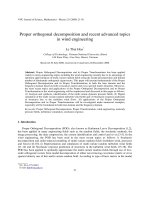Noel kalicharan advanced topics in c core concepts in data structures
Bạn đang xem bản rút gọn của tài liệu. Xem và tải ngay bản đầy đủ của tài liệu tại đây (4.65 MB, 304 trang )
Kalicharan
Shelve in
Programming Languages / ANSI C
User level:
Intermediate
www.apress.com
SOURCE CODE ONLINE
BOOKS FOR PROFESSIONALS BY PROFESSIONALS
®
Advanced Topics in C
C is the most widely used programming language of all time. It has been used to
create almost every category of software imaginable and the list keeps growing
every day. Cutting-edge applications, such as Arduino, embeddable and wearable
computing are ready-made for C.
Advanced Programming In C teaches concepts that any budding programmer
should know. You’ll delve into topics such as sorting, searching, merging, recur-
sion, random numbers and simulation, among others. You will increase the range
of problems you can solve when you learn how to manipulate versatile and popular
data structures such as binary trees and hash tables.
This book assumes you have a working knowledge of basic programming con-
cepts such as variables, constants, assignment, selection (if else) and looping
(while, for). It also assumes you are comfortable with writing functions and working
with arrays. If you study this book carefully and do the exercises conscientiously,
you would become a better and more agile programmer, more prepared to code
today’s applications (such as the Internet of Things) in C.
With Advanced Programming In C, you will learn:
• What are and how to use structures, pointers, and linked lists
• How to manipulate and use stacks and queues
• How to use random numbers to program games, and simulations
• How to work with files, binary trees, and hash tables
• Sophisticated sorting methods such as heapsort, quicksort, and mergesort
• How to implement all of the above using C
RELATED
9 781430264002
ISBN 978-1-4302-6400-2
For your convenience Apress has placed some of the front
matter material after the index. Please use the Bookmarks
and Contents at a Glance links to access them.
v
Contents at a Glance
About the Author ���������������������������������������������������������������������������������������������������������������xiii
About the Technical Reviewer �������������������������������������������������������������������������������������������� xv
Preface ����������������������������������������������������������������������������������������������������������������������������� xvii
Chapter 1: Sorting, Searching, and Merging ■ ���������������������������������������������������������������������1
Chapter 2: Structures ■ ������������������������������������������������������������������������������������������������������27
Chapter 3: Pointers ■ ����������������������������������������������������������������������������������������������������������51
Chapter 4: Linked Lists ■ ����������������������������������������������������������������������������������������������������69
Chapter 5: Stacks and Queues ■ ���������������������������������������������������������������������������������������103
Chapter 6: Recursion ■ �����������������������������������������������������������������������������������������������������133
Chapter 7: Random Numbers, Games, and Simulation ■ ��������������������������������������������������159
Chapter 8: Working with Files ■ ���������������������������������������������������������������������������������������183
Chapter 9: Introduction to Binary Trees ■ ������������������������������������������������������������������������213
Chapter 10: Advanced Sorting ■ ���������������������������������������������������������������������������������������241
Chapter 11: Hashing ■ ������������������������������������������������������������������������������������������������������265
Index ���������������������������������������������������������������������������������������������������������������������������������287
1
Chapter 1
Sorting, Searching, and Merging
In this chapter, we will explain the following:
How to sort a list of items using selection and insertion sort•
How to add a new item to a sorted list so that the list remains sorted•
How to sort an array of strings•
How to sort related (parallel) arrays•
How to search a sorted list using • binary search
How to search an array of strings•
How to write a program to do a frequency count of words in a passage•
How to merge two sorted lists to create one sorted list•
1.1 Sorting an Array: Selection Sort
Sorting is the process by which a set of values are arranged in ascending or descending order. There are many reasons
to sort. Sometimes we sort in order to produce more readable output (for example, to produce an alphabetical listing).
A teacher may need to sort her students in order by name or by average score. If we have a large set of values and we
want to identify duplicates, we can do so by sorting; the repeated values will come together in the sorted list.
Another advantage of sorting is that some operations can be performed faster and more efficiently with sorted
data. For example, if data is sorted, it is possible to search it using binary search—this is much faster than using a
sequential search. Also, merging two separate lists of items can be done much faster than if the lists were unsorted.
There are many ways to sort. In this chapter, we will discuss two of the “simple” methods: selection and insertion
sort. In Chapter 10, we will look at more sophisticated ways to sort. We start with selection sort.
Consider the following list of numbers stored in a C array, num:
CHAPTER 1 ■ SORTING, SEARCHING, AND MERGING
2
Sorting num in ascending order using selection sort proceeds as follows:
1
st
pass
Find the smallest number in the entire list, from positions • 0 to 6; the smallest is 15, found
in position 4.
Interchange the numbers in positions • 0 and 4. This gives us the following:
2
nd
pass
Find the smallest number in positions • 1 to 6; the smallest is 33, found in position 5.
Interchange the numbers in positions • 1 and 5. This gives us the following:
3
rd
pass
Find the smallest number in positions • 2 to 6; the smallest is 48, found in position 5.
Interchange the numbers in positions • 2 and 5. This gives us the following:
4
th
pass
Find the smallest number in positions • 3 to 6; the smallest is 52, found in position 6.
Interchange the numbers in positions • 3 and 6. This gives us the following:
5
th
pass
Find the smallest number in positions • 4 to 6; the smallest is 57, found in position 4.
Interchange the numbers in positions • 4 and 4. This gives us the following:
CHAPTER 1 ■ SORTING, SEARCHING, AND MERGING
3
6
th
pass
Find the smallest number in positions • 5 to 6; the smallest is 65, found in position 6.
Interchange the numbers in positions • 5 and 6. This gives us the following:
The array is now completely sorted. Note that once the 6
th
largest (65) has been placed in its final position (5),
the largest (79) would automatically be in the last position (6).
In this example, we made six passes. We will count these passes by letting the variable h go from 0 to 5. On each
pass, we find the smallest number from positions h to 6. If the smallest number is in position s, we interchange the
numbers in positions h and s.
In general, for an array of size n, we make n-1 passes. In our example, we sorted seven numbers in six passes.
The following is a pseudocode outline of the algorithm for sorting num[0 n-1]:
for h = 0 to n - 2
s = position of smallest number from num[h] to num[n-1]
swap num[h] and num[s]
endfor
We can implement this algorithm as follows, using the generic parameter, list:
void selectionSort(int list[], int lo, int hi) {
//sort list[lo] to list[hi] in ascending order
int getSmallest(int[], int, int);
void swap(int[], int, int);
for (int h = lo; h < hi; h++) {
int s = getSmallest(list, h, hi);
swap(list, h, s);
}
}
The two statements in the for loop could be replaced by this:
swap(list, h, getSmallest(list, h, hi));
We can write getSmallest and swap as follows:
int getSmallest(int list[], int lo, int hi) {
//return location of smallest from list[lo hi]
int small = lo;
for (int h = lo + 1; h <= hi; h++)
if (list[h] < list[small]) small = h;
return small;
}
CHAPTER 1 ■ SORTING, SEARCHING, AND MERGING
4
void swap(int list[], int i, int j) {
//swap elements list[i] and list[j]
int hold = list[i];
list[i] = list[j];
list[j] = hold;
}
To test whether selectionSort works properly, we write Program P1.1. Only main is shown. To complete the
program, just add selectionSort, getSmallest, and swap.
Program P1.1
#include <stdio.h>
#define MaxNumbers 10
int main() {
void selectionSort(int [], int, int);
int num[MaxNumbers];
printf("Type up to %d numbers followed by 0\n", MaxNumbers);
int n = 0, v;
scanf("%d", &v);
while (v != 0 && n < MaxNumbers) {
num[n++] = v;
scanf("%d", &v);
}
if (v != 0) {
printf("More than %d numbers entered\n", MaxNumbers);
printf("First %d used\n", MaxNumbers);
}
//n numbers are stored from num[0] to num[n-1]
selectionSort(num, 0, n-1);
printf("\nThe sorted numbers are\n");
for (int h = 0; h < n; h++) printf("%d ", num[h]);
printf("\n");
}
The program requests up to ten numbers (as defined by MaxNumbers), stores them in the array num, calls
selectionSort, and then prints the sorted list.
The following is a sample run of the program:
Type up to 10 numbers followed by 0
57 48 79 65 15 33 52 0
The sorted numbers are
15 33 48 52 57 65 79
Note that if the user enters more than ten numbers, the program will recognize this and sort only the first ten.
CHAPTER 1 ■ SORTING, SEARCHING, AND MERGING
5
1.1.1 Analysis of Selection Sort
To find the smallest of k items, we make k-1 comparisons. On the first pass, we make n-1 comparisons to find the
smallest of n items. On the second pass, we make n-2 comparisons to find the smallest of n-1 items. And so on, until
the last pass where we make one comparison to find the smaller of two items. In general, on the jth pass, we make n-j
comparisons to find the smallest of n-j+1 items. Hence:
total number of comparisons = 1 + 2 + + n-1 = ½ n(n-1) » ½ n2
We say selection sort is of order O(n
2
) (“big O n squared”). The constant ½ is not important in “big O” notation
since, as n gets very big, the constant becomes insignificant.
On each pass, we swap two items using three assignments. Since we make n-1 passes, we make 3(n-1)
assignments in all. Using “big O” notation, we say that the number of assignments is O(n). The constants 3 and 1 are
not important as n gets large.
Does selection sort perform any better if there is order in the data? No. One way to find out is to give it a sorted list
and see what it does. If you work through the algorithm, you will see that the method is oblivious to order in the data.
It will make the same number of comparisons every time, regardless of the data.
As we will see, some sorting methods, such as mergesort and quicksort (see Chapters 6 and 10) require extra
array storage to implement them. Note that selection sort is performed “in place” in the given array and does not
require additional storage.
As an exercise, modify the programming code so that it counts the number of comparisons and assignments
made in sorting a list using selection sort.
1.2 Sorting an Array: Insertion Sort
Consider the same array as before:
Now, think of the numbers as cards on a table that are picked up one at a time, in the order they appear in the
array. Thus, we first pick up 57, then 48, then 79, and so on, until we pick up 52. However, as we pick up each new
number, we add it to our hand in such a way that the numbers in our hand are all sorted.
When we pick up 57, we have just one number in our hand. We consider one number to be sorted.
When we pick up 48, we add it in front of 57 so our hand contains the following:
48 57
When we pick up 79, we place it after 57 so our hand contains the following:
48 57 79
When we pick up 65, we place it after 57 so our hand contains the following:
48 57 65 79
At this stage, four numbers have been picked up, and our hand contains them in sorted order.
CHAPTER 1 ■ SORTING, SEARCHING, AND MERGING
6
When we pick up 15, we place it before 48 so our hand contains the following:
15 48 57 65 79
When we pick up 33, we place it after 15 so our hand contains the following:
15 33 48 57 65 79
Finally, when we pick up 52, we place it after 48 so our hand contains the following:
15 33 48 52 57 65 79
The numbers have been sorted in ascending order.
The method described illustrates the idea behind insertion sort. The numbers in the array will be processed one
at a time, from left to right. This is equivalent to picking up the numbers from the table, one at a time. Since the first
number, by itself, is sorted, we will process the numbers in the array starting from the second.
When we come to process num[h], we can assume that num[0] to num[h-1] are sorted. We insert num[h] among
num[0] to num[h-1] so that num[0] to num[h] are sorted. We then go on to process num[h+1]. When we do so, our
assumption that num[0] to num[h] are sorted will be true.
Sorting num in ascending order using insertion sort proceeds as follows:
1
st
pass
Process • num[1], that is, 48. This involves placing 48 so that the first two numbers are sorted;
num[0] and num[1] now contain the following:
The rest of the array remains unchanged.
2
nd
pass
Process • num[2], that is, 79. This involves placing 79 so that the first three numbers are sorted;
num[0] to num[2] now contain the following:
The rest of the array remains unchanged.
3
rd
pass
Process • num[3], that is, 65. This involves placing 65 so that the first four numbers are sorted;
num[0] to num[3] now contain the following:
CHAPTER 1 ■ SORTING, SEARCHING, AND MERGING
7
The rest of the array remains unchanged.
4
th
pass
Process • num[4], that is, 15. This involves placing 15 so that the first five numbers are sorted.
To simplify the explanation, think of 15 as being taken out and stored in a simple variable
(key, say) leaving a “hole” in num[4]. We can picture this as follows:
The insertion of 15 in its correct position proceeds as follows:
Compare • 15 with 79; it is smaller, so move 79 to location 4, leaving location 3 free. This gives
the following:
Compare • 15 with 65; it is smaller, so move 65 to location 3, leaving location 2 free. This gives
the following:
Compare • 15 with 57; it is smaller, so move 57 to location 2, leaving location 1 free. This gives
the following:
Compare • 15 with 48; it is smaller, so move 48 to location 1, leaving location 0 free. This gives
the following:
CHAPTER 1 ■ SORTING, SEARCHING, AND MERGING
8
There are no more numbers to compare with • 15, so it is inserted in location 0, giving
the following:
We can express the logic of placing • 15 (key) by comparing it with the numbers to its left,
starting with the nearest one. As long as key is less than num[k], for some k, we move num[k]
to position num[k + 1] and move on to consider num[k-1], providing it exists. It won’t exist
when k is actually 0. In this case, the process stops, and key is inserted in position 0.
5
th
pass
Process • num[5], that is, 33. This involves placing 33 so that the first six numbers are sorted.
This is done as follows:
Store • 33 in key, leaving location 5 free;
Compare • 33 with 79; it is smaller, so move 79 to location 5, leaving location 4 free.
Compare • 33 with 65; it is smaller, so move 65 to location 4, leaving location 3 free.
Compare • 33 with 57; it is smaller, so move 57 to location 3, leaving location 2 free.
Compare • 33 with 48; it is smaller, so move 48 to location 2, leaving location 1 free.
Compare • 33 with 15; it is bigger, so insert 33 in location 1. This gives the following:
We can express the logic of placing • 33 by comparing it with the numbers to its left, starting
with the nearest one. As long as key is less than num[k], for some k, we move num[k] to
position num[k + 1] and move on to consider num[k-1], providing it exists. If key is greater
than or equal to num[k] for some k, then key is inserted in position k+1. Here, 33 is greater
than num[0] and so is inserted into num[1].
6
th
pass
Process • num[6], that is, 52. This involves placing 52 so that the first seven (all) numbers are
sorted. This is done as follows:
Store • 52 in key, leaving location 6 free.
Compare • 52 with 79; it is smaller, so move 79 to location 6, leaving location 5 free.
Compare • 52 with 65; it is smaller, so move 65 to location 5, leaving location 4 free.
CHAPTER 1 ■ SORTING, SEARCHING, AND MERGING
9
Compare • 52 with 57; it is smaller, so move 57 to location 4, leaving location 3 free.
Compare • 52 with 48; it is bigger, so insert 52 in location 3. This gives the following:
The array is now completely sorted.
The following is an outline of how to sort the first n elements of an array, num, using insertion sort:
for h = 1 to n - 1 do
insert num[h] among num[0] to num[h-1] so that num[0] to num[h] are sorted
endfor
Using this outline, we write the function insertionSort using the parameter list.
void insertionSort(int list[], int n) {
//sort list[0] to list[n-1] in ascending order
for (int h = 1; h < n; h++) {
int key = list[h];
int k = h - 1; //start comparing with previous item
while (k >= 0 && key < list[k]) {
list[k + 1] = list[k];
k;
}
list[k + 1] = key;
} //end for
} //end insertionSort
The while statement is at the heart of the sort. It states that as long as we are within the array (k >= 0) and the
current number (key) is less than the one in the array (key < list[k]), we move list[k] to the right
(list[k + 1] = list[k]) and move on to the next number on the left ( k).
We exit the while loop if k is equal to -1 or if key is greater than or equal to list[k], for some k. In either case,
key is inserted into list[k + 1].
If k is -1, it means that the current number is smaller than all the previous numbers in the list and must be
inserted in list[0]. But list[k + 1] is list[0] when k is -1, so key is inserted correctly in this case.
The function sorts in ascending order. To sort in descending order, all we have to do is change < to > in the while
condition, like this:
while (k >= 0 && key > list[k])
Now, a key moves to the left if it is bigger.
We write Program P1.2 to test whether insertionSort works correctly. Only main is shown. Adding the function
insertionSort completes the program.
CHAPTER 1 ■ SORTING, SEARCHING, AND MERGING
10
Program P1.2
#include <stdio.h>
#define MaxNumbers 10
int main() {
void insertionSort(int [], int);
int num[MaxNumbers];
printf("Type up to %d numbers followed by 0\n", MaxNumbers);
int n = 0, v;
scanf("%d", &v);
while (v != 0 && n < MaxNumbers) {
num[n++] = v;
scanf("%d", &v);
}
if (v != 0) {
printf("More than %d numbers entered\n", MaxNumbers);
printf("First %d used\n", MaxNumbers);
}
//n numbers are stored from num[0] to num[n-1]
insertionSort(num, n);
printf("\nThe sorted numbers are\n");
for (int h = 0; h < n; h++) printf("%d ", num[h]);
printf("\n");
}
The program requests up to ten numbers (as defined by MaxNumbers), stores them in the array num, calls
insertionSort, and then prints the sorted list.
The following is a sample run of the program:
Type up to 10 numbers followed by 0
57 48 79 65 15 33 52 0
The sorted numbers are
15 33 48 52 57 65 79
Note that if the user enters more than ten numbers, the program will recognize this and sort only the first ten.
We could easily generalize insertionSort to sort a portion of a list. To illustrate, we rewrite insertionSort
(calling it insertionSort1) to sort list[lo] to list[hi] where lo and hi are passed as arguments to the function.
Since element lo is the first one, we start processing elements from lo+1 until element hi. This is reflected in the
for statement. Also now, the lowest subscript is lo, rather than 0. This is reflected in the while condition k >= lo.
Everything else remains the same as before.
void insertionSort1(int list[], int lo, int hi) {
//sort list[lo] to list[hi] in ascending order
for (int h = lo + 1; h <= hi; h++) {
int key = list[h];
int k = h - 1; //start comparing with previous item
while (k >= lo && key < list[k]) {
list[k + 1] = list[k];
k;
}
CHAPTER 1 ■ SORTING, SEARCHING, AND MERGING
11
list[k + 1] = key;
} //end for
} //end insertionSort1
1.2.1 Analysis of Insertion Sort
In processing item j, we can make as few as one comparison (if num[j] is bigger than num[j-1]) or as many as j-1
comparisons (if num[j] is smaller than all the previous items). For random data, we would expect to make ½(j-1)
comparisons, on average. Hence, the average total number of comparisons to sort n items is as follows:
We say insertion sort is of order O(n
2
) (“big O n squared”). The constant ¼ is not important as n gets large.
Each time we make a comparison, we also make an assignment. Hence, the total number of assignments is
also ¼ n(n-1) » ¼ n
2
.
We emphasize that this is an average for random data. Unlike selection sort, the actual performance of insertion
sort depends on the data supplied. If the given array is already sorted, insertion sort will quickly determine this by
making n-1 comparisons. In this case, it runs in O(n) time. One would expect that insertion sort will perform better
the more order there is in the data.
If the given data is in descending order, insertion sort performs at its worst since each new number has to travel
all the way to the beginning of the list. In this case, the number of comparisons is ½ n(n-1) » ½ n
2
. The number of
assignments is also ½ n(n-1) » ½ n
2
.
Thus, the number of comparisons made by insertion sort ranges from n-1 (best) to ¼ n
2
(average) to ½ n
2
(worst).
The number of assignments is always the same as the number of comparisons.
As with selection sort, insertion sort does not require extra array storage for its implementation.
As an exercise, modify the programming code so that it counts the number of comparisons and assignments
made in sorting a list using insertion sort.
1.3 Inserting an Element in Place
Insertion sort uses the idea of adding a new element to an already sorted list so that the list remains sorted. We can
treat this as a problem in its own right (nothing to do with insertion sort). Specifically, given a sorted list of items from
list[m] to list[n], we want to add a new item (newItem, say) to the list so that list[m] to list[n + 1] are sorted.
Adding a new item increases the size of the list by 1. We assume that the array has room to hold the new item.
We write the function insertInPlace to solve this problem.
void insertInPlace(int newItem, int list[], int m, int n) {
//list[m] to list[n] are sorted
//insert newItem so that list[m] to list[n+1] are sorted
int k = n;
while (k >= m && newItem < list[k]) {
list[k + 1] = list[k];
k;
}
list[k + 1] = newItem;
} //end insertInPlace
2
2
1
1 11
( 1) {1 2 1} ( 1)
2 44
2
n
j
j n nn n
=
−= +++−= −≈
∑
CHAPTER 1 ■ SORTING, SEARCHING, AND MERGING
12
Using insertInPlace, we can rewrite insertionSort (calling it insertionSort2) as follows:
void insertionSort2(int list[], int lo, int hi) {
//sort list[lo] to list[hi] in ascending order
void insertInPlace(int, int [], int, int);
for (int h = lo + 1; h <= hi; h++)
insertInPlace(list[h], list, lo, h - 1);
} //end insertionSort2
1.4 Sorting an Array of Strings
Consider the problem of sorting a list of names in alphabetical order. In C, each name is stored in a character array.
To store several names, we need a two-dimensional character array. For example, we can store eight names as shown
in Figure 1-1.
012345678910 11 12 13 14
0
Tayl or ,Victor\0
1
Duncan,Denise\0
2
Ramd han, Kama l\0
3
Si ngh, Kr ishna\0
4
Al i, Mi chael\0
5
Sawh ,Ani sa\0
6
Khan,Carol \0
7
Owen,David\0
Figure 1-1. Two-dimensional character array
Doing so will require a declaration such as the following:
char list[8][15];
To cater for longer names, we can increase 15, and to cater for more names, we can increase 8.
The process of sorting list is essentially the same as sorting an array of integers. The major difference is
that whereas we use < to compare two numbers, we must use strcmp to compare two names. In the function
insertionSort shown at the end of Section 1.3, the while condition changes from this:
while (k >= lo && key < list[k])
to the following, where key is now declared as char key[15]:
while (k >= lo && strcmp(key, list[k]) < 0)
Also, we must now use strcpy (since we can’t use = for strings) to assign a name to another location. Here is the
complete function:
void insertionSort3(int lo, int hi, int max, char list[][max]) {
//Sort the strings in list[lo] to list[hi] in alphabetical order.
//The maximum string size is max - 1 (one char taken up by \0).
CHAPTER 1 ■ SORTING, SEARCHING, AND MERGING
13
char key[max];
for (int h = lo + 1; h <= hi; h++) {
strcpy(key, list[h]);
int k = h - 1; //start comparing with previous item
while (k >= lo && strcmp(key, list[k]) < 0) {
strcpy(list[k + 1], list[k]);
k;
}
strcpy(list[k + 1], key);
} //end for
} //end insertionSort3
Note the declaration of list (char list[][max]) in the parameter list. The size of the first dimension is left
unspecified, as for one-dimensional arrays. The size of the second dimension is specified using the parameter max;
the value of max will be specified when the function is called. This gives us a bit more flexibility since we can specify
the size of the second dimension at run time.
We write a simple main routine to test insertionSort3 as shown in Program P1.3.
Program P1.3
#include <stdio.h>
#include <string.h>
#define MaxNameSize 14
#define MaxNameBuffer MaxNameSize+1
#define MaxNames 8
int main() {
void insertionSort3(int, int, int max, char [][max]);
char name[MaxNames][MaxNameBuffer] = {"Taylor, Victor", "Duncan, Denise",
"Ramdhan, Kamal", "Singh, Krishna", "Ali, Michael",
"Sawh, Anisa", "Khan, Carol", "Owen, David" };
insertionSort3(0, MaxNames-1, MaxNameBuffer, name);
printf("\nThe sorted names are\n\n");
for (int h = 0; h < MaxNames; h++) printf("%s\n", name[h]);
} //end main
The declaration of name initializes it with the eight names shown in Figure 1-1. When run, the program produces
the following output:
The sorted names are
Ali, Michael
Duncan, Denise
Khan, Carol
Owen, David
Ramdhan, Kamal
Sawh, Anisa
Singh, Krishna
Taylor, Victor
CHAPTER 1 ■ SORTING, SEARCHING, AND MERGING
14
1.5 Sorting Parallel Arrays
It is quite common to have related information in different arrays. For example, suppose, in addition to name, we have
an integer array id such that id[h] is an identification number associated with name[h], as shown in Figure 1-2.
nam e id
0
Taylor, Victor 3050
1
Duncan, Denise 2795
2
Ramdhan, Kamal4455
3
Singh, Krishna 7824
4
A
li, Michael6669
5
Sawh, Anisa5000
6
Khan, Carol 5464
7
Owen, David 6050
Figure 1-2. Two arrays with related information
Consider the problem of sorting the names in alphabetical order. At the end, we would want each name to have
its correct ID number. So, for example, after the sorting is done, name[0] should contain “Ali, Michael” and id[0]
should contain 6669.
To achieve this, each time a name is moved during the sorting process, the corresponding ID number must also
be moved. Since the name and ID number must be moved “in parallel,” we say we are doing a parallel sort or we are
sorting parallel arrays.
We rewrite insertionSort3 to illustrate how to sort parallel arrays. We simply add the code to move an ID
whenever a name is moved. We call it parallelSort.
void parallelSort(int lo, int hi, int max, char list[][max], int id[]) {
//Sort the names in list[lo] to list[hi] in alphabetical order, ensuring that
//each name remains with its original id number.
//The maximum string size is max - 1 (one char taken up by \0).
char key[max];
for (int h = lo + 1; h <= hi; h++) {
strcpy(key, list[h]);
int m = id[h]; // extract the id number
int k = h - 1; //start comparing with previous item
while (k >= lo && strcmp(key, list[k]) < 0) {
strcpy(list[k + 1], list[k]);
id[k + 1] = id[k]; // move up id number when we move a name
k;
}
strcpy(list[k + 1], key);
id[k + 1] = m; // store the id number in the same position as the name
} //end for
} //end parallelSort
CHAPTER 1 ■ SORTING, SEARCHING, AND MERGING
15
We test parallelSort by writing the following main routine:
#include <stdio.h>
#include <string.h>
#define MaxNameSize 14
#define MaxNameBuffer MaxNameSize+1
#define MaxNames 8
int main() {
void parallelSort(int, int, int max, char [][max], int[]);
char name[MaxNames][MaxNameBuffer] = {"Taylor, Victor", "Duncan, Denise",
"Ramdhan, Kamal", "Singh, Krishna", "Ali, Michael",
"Sawh, Anisa", "Khan, Carol", "Owen, David" };
int id[MaxNames] = {3050,2795,4455,7824,6669,5000,5464,6050};
parallelSort(0, MaxNames-1, MaxNameBuffer, name, id);
printf("\nThe sorted names and IDs are\n\n");
for (int h = 0; h < MaxNames; h++) printf("%-18s %d\n", name[h], id[h]);
} //end main
When run, it produces the following output:
The sorted names and IDs are
Ali, Michael 6669
Duncan, Denise 2795
Khan, Carol 5464
Owen, David 6050
Ramdhan, Kamal 4455
Sawh, Anisa 5000
Singh, Krishna 7824
Taylor, Victor 3050
1.6 Binary Search
Binary search is a fast method for searching a list of items for a given one, providing the list is sorted (either ascending
or descending). To illustrate the method, consider a list of 13 numbers, sorted in ascending order and stored in an
array num[0 12].
Suppose we want to search for 66. The search proceeds as follows:
1. First, we find the middle item in the list. This is 56 in position 6. We compare 66 with 56.
Since 66 is bigger, we know that if 66 is in the list at all, it must be after position 6, since the
numbers are in ascending order. In our next step, we confine our search to locations 7 to 12.
2. Next, we find the middle item from locations 7 to 12. In this case, we can choose either
item 9 or item 10. The algorithm we will write will choose item 9, that is, 78.
CHAPTER 1 ■ SORTING, SEARCHING, AND MERGING
16
3. We compare 66 with 78. Since 66 is smaller, we know that if 66 is in the list at all, it must be
before position 9, since the numbers are in ascending order. In our next step, we confine
our search to locations 7 to 8.
4. Next, we find the middle item from locations 7 to 8. In this case, we can choose either item
7 or item 8. The algorithm we will write will choose item 7, that is, 66.
5. We compare 66 with 66. Since they are the same, our search ends successfully, finding the
required item in position 7.
Suppose we were searching for 70. The search will proceed as described above until we compare 70 with 66
(in location 7).
1. Since 70 is bigger, we know that if 70 is in the list at all, it must be after position 7, since the
numbers are in ascending order. In our next step, we confine our search to locations 8 to 8.
This is just one location.
2. We compare 70 with item 8, that is, 72. Since 70 is smaller, we know that if 70 is in the list at
all, it must be before position 8. Since it can’t be after position 7 and before position 8,
we conclude that it is not in the list.
At each stage of the search, we confine our search to some portion of the list. Let us use the variables lo and hi
as the subscripts that define this portion. In other words, our search will be confined to num[lo] to num[hi].
Initially, we want to search the entire list so that we will set lo to 0 and hi to 12, in this example.
How do we find the subscript of the middle item? We will use the following calculation:
mid = (lo + hi) / 2;
Since integer division will be performed, the fraction, if any, is discarded. For example, when lo is 0 and hi is 12,
mid becomes 6; when lo is 7 and hi is 12, mid becomes 9; and when lo is 7 and hi is 8, mid becomes 7.
As long as lo is less than or equal to hi, they define a nonempty portion of the list to be searched. When lo is
equal to hi, they define a single item to be searched. If lo ever gets bigger than hi, it means we have searched the
entire list and the item was not found.
Based on these ideas, we can now write a function binarySearch. To be more general, we will write it so that the
calling routine can specify which portion of the array it wants the search to look for the item.
Thus, the function must be given the item to be searched for (key), the array (list), the start position of the
search (lo), and the end position of the search (hi). For example, to search for the number 66 in the array num, shown
earlier, we can issue the call binarySearch(66, num, 0, 12).
The function must tell us the result of the search. If the item is found, the function will return its location. If not
found, it will return -1.
int binarySearch(int key, int list[], int lo, int hi) {
//search for key from list[lo] to list[hi]
//if found, return its location; otherwise, return -1
while (lo <= hi) {
int mid = (lo + hi) / 2;
if (key == list[mid]) return mid; // found
if (key < list[mid]) hi = mid - 1;
else lo = mid + 1;
}
return -1; //lo and hi have crossed; key not found
} //end binarySearch
CHAPTER 1 ■ SORTING, SEARCHING, AND MERGING
17
If item contains a number to be searched for, we can write code as follows:
int ans = binarySearch(item, num, 0, 12);
if (ans == -1) printf(“%d not found\n”, item);
else printf(“%d found in location %d\n”, item, ans);
If we want to search for item from locations i to j, we can write the following:
int ans = binarySearch(item, num, i, j);
1.7 Searching an Array of Strings
We can search a sorted array of strings (names in alphabetical order, say) using the same technique we used for
searching an integer array. The major differences are in the declaration of the array and the use of strcmp, rather than
== or <, to compare two strings. The following is the string version of binarySearch:
int binarySearch(int lo, int hi, char key[], int max, char list[][max]) {
//search for key from list[lo] to list[hi]
//if found, return its location; otherwise, return -1
while (lo <= hi) {
int mid = (lo + hi) / 2;
int cmp = strcmp(key, list[mid]);
if (cmp == 0) return mid; // found
if (cmp < 0) hi = mid - 1;
else lo = mid + 1;
}
return -1; //lo and hi have crossed; key not found
} //end binarySearch
The function can be tested with main shown in Program P1.4.
Program P1.4
#include <stdio.h>
#include <string.h>
#define MaxNameSize 14
#define MaxNameBuffer MaxNameSize+1
#define MaxNames 8
int main () {
int binarySearch(int, int, char [], int max, char [][max]);
int n;
char name[MaxNames][MaxNameBuffer] = {"Ali, Michael","Duncan, Denise",
"Khan, Carol","Owen, David", "Ramdhan, Kamal",
"Sawh, Anisa", "Singh, Krishna", "Taylor, Victor"};
n = binarySearch(0, 7, "Ali, Michael", MaxNameBuffer, name);
printf("%d\n", n); //will print 0, location of Ali, Michael
n = binarySearch(0, 7, "Taylor, Victor", MaxNameBuffer, name);
printf("%d\n", n); //will print 7, location of Taylor, Victor
n = binarySearch(0, 7, "Owen, David", MaxNameBuffer, name);
printf("%d\n", n); //will print 3, location of Owen, David
CHAPTER 1 ■ SORTING, SEARCHING, AND MERGING
18
n = binarySearch(4, 7, "Owen, David", MaxNameBuffer, name);
printf("%d\n", n); //will print -1, since Owen, David is not in locations 4 to 7
n = binarySearch(0, 7, "Sandy, Cindy", MaxNameBuffer, name);
printf("%d\n", n); //will print -1 since Sandy, Cindy is not in the list
} //end main
This sets up the array name with the names in alphabetical order. It then calls binarySearch with various names
and prints the result of each search.
One may wonder what might happen with a call like this:
n = binarySearch(5, 10, MaxNameBuffer, "Sawh, Anisa", name);
Here, we are telling binarySearch to look for “Sawh, Anisa” in locations 5 to 10 of the given array. However,
locations 8 to 10 do not exist in the array. The result of the search will be unpredictable. The program may crash or
return an incorrect result. The onus is on the calling program to ensure that binarySearch (or any other function) is
called with valid arguments.
1.8 Example: Word Frequency Count
Let’s write a program to read an English passage and count the number of times each word appears. The output
consists of an alphabetical listing of the words and their frequencies.
We can use the following outline to develop our program:
while there is input
get a word
search for word
if word is in the table
add 1 to its count
else
add word to the table
set its count to 1
endif
endwhile
print table
This is a typical “search and insert” situation. We search for the next word among the words stored so far. If the
search succeeds, we need only increment its count. If the search fails, the word is put in the table, and its count set to 1.
A major design decision here is how to search the table, which, in turn, will depend on where and how a new
word is inserted in the table. The following are two possibilities:
1. A new word is inserted in the next free position in the table. This implies that a sequential
search must be used to look for an incoming word since the words would not be in any
particular order. This method has the advantages of simplicity and easy insertion, but
searching takes longer because more words are put in the table.
2. A new word is inserted in the table in such a way that the words are always in alphabetical
order. This may entail moving words that have already been stored so that the new word
may be slotted in the right place. However, since the table is in order, a binary search can
be used to search for an incoming word.
For (2), searching is faster, but insertion is slower than in (1). Since, in general, searching is done more frequently
than inserting, (2) might be preferable.
CHAPTER 1 ■ SORTING, SEARCHING, AND MERGING
19
Another advantage of (2) is that, at the end, the words will already be in alphabetical order and no sorting will be
required. If (1) is used, the words will need to be sorted to obtain the alphabetical order.
We will write our program using the approach in (2). The complete program is shown as Program P1.5.
Program P1.5
#include <stdio.h>
#include <string.h>
#include <ctype.h>
#include <stdlib.h>
#define MaxWords 50
#define MaxLength 10
#define MaxWordBuffer MaxLength+1
int main() {
int getWord(FILE *, char[]);
int binarySearch(int, int, char [], int max, char [][max]);
void addToList(char[], int max, char [][max], int[], int, int);
void printResults(FILE *, int max, char [][max], int[], int);
char wordList[MaxWords][MaxWordBuffer], word[MaxWordBuffer];
int frequency[MaxWords], numWords = 0;
FILE * in = fopen("passage.txt", "r");
if (in == NULL){
printf("Cannot find file\n");
exit(1);
}
FILE * out = fopen("output.txt", "w");
if (out == NULL){
printf("Cannot create output file\n");
exit(2);
}
for (int h = 0; h < MaxWords; h++) frequency[h] = 0;
while (getWord(in, word) != 0) {
int loc = binarySearch (0, numWords-1, word, MaxWordBuffer, wordList);
if (strcmp(word, wordList[loc]) == 0) ++frequency[loc]; //word found
else //this is a new word
if (numWords < MaxWords) { //if table is not full
addToList(word, MaxWordBuffer, wordList, frequency, loc, numWords-1);
++numWords;
}
else fprintf(out, "'%s' not added to table\n", word);
}
printResults(out, MaxWordBuffer, wordList, frequency, numWords);
} // end main
CHAPTER 1 ■ SORTING, SEARCHING, AND MERGING
20
int getWord(FILE * in, char str[]) {
// stores the next word, if any, in str; word is converted to lowercase
// returns 1 if a word is found; 0, otherwise
char ch;
int n = 0;
// read over white space
while (!isalpha(ch = getc(in)) && ch != EOF) ; //empty while body
if (ch == EOF) return 0;
str[n++] = tolower(ch);
while (isalpha(ch = getc(in)) && ch != EOF)
if (n < MaxLength) str[n++] = tolower(ch);
str[n] = '\0';
return 1;
} // end getWord
int binarySearch(int lo, int hi, char key[], int max, char list[][max]) {
//search for key from list[lo] to list[hi]
//if found, return its location;
//if not found, return the location in which it should be inserted
//the calling program will check the location to determine if found
while (lo <= hi) {
int mid = (lo + hi) / 2;
int cmp = strcmp(key, list[mid]);
if (cmp == 0) return mid; // found
if (cmp < 0) hi = mid - 1;
else lo = mid + 1;
}
return lo; //not found; should be inserted in location lo
} //end binarySearch
void addToList(char item[], int max, char list[][max], int freq[], int p, int n) {
//adds item in position list[p]; sets freq[p] to 1
//shifts list[n] down to list[p] to the right
for (int h = n; h >= p; h ) {
strcpy(list[h+1], list[h]);
freq[h+1] = freq[h];
}
strcpy(list[p], item);
freq[p] = 1;
} //end addToList
void printResults(FILE *out, int max, char list[][max], int freq[], int n) {
fprintf(out, "\nWords Frequency\n\n");
for (int h = 0; h < n; h++)
fprintf(out, "%-15s %2d\n", list[h], freq[h]);
} //end printResults
CHAPTER 1 ■ SORTING, SEARCHING, AND MERGING
21
When Program P1.5 was run with this data, it produced the output that follows:
The quick brown fox jumps over the lazy dog. Congratulations!
If the quick brown fox jumped over the lazy dog then
Why did the quick brown fox jump over the lazy dog?
To recuperate!
Here is the output:
Words Frequency
brown 3
congratula 1
did 1
dog 3
fox 3
if 1
jump 1
jumped 1
jumps 1
lazy 3
over 3
quick 3
recuperate 1
the 6
then 1
to 1
why 1
The following are comments on Program P1.5:
For our purposes, we assume that a word begins with a letter and consists of letters only. If you •
want to include other characters (such as a hyphen or apostrophe), you need change only the
getWord function.
• MaxWords denotes the maximum number of distinct words catered for. For testing the
program, we have used 50 for this value. If the number of distinct words in the passage
exceeds MaxWords (50, say), any words after the 50
th
will be read but not stored, and a message
to that effect will be printed. However, the count for a word already stored will be incremented
if it is encountered again.
• MaxLength (we use 10 for testing) denotes the maximum length of a word. Strings are declared
using MaxLength+1 (defined as MaxWordBuffer) to cater for \0, which must be added at
the end of each string.
• main checks that the input file exists and that the output file can be created. Next, it initializes
the frequency counts to 0. It then processes the words in the passage based on the outline
shown at the start of Section 1.8.
• getWord reads the input file and stores the next word found in its string argument. It returns 1
if a word is found and 0, otherwise. If a word is longer than MaxLength, only the first MaxLength
letters are stored; the rest are read and discarded. For example, congratulations is truncated
to congratula using a word size of 10.
CHAPTER 1 ■ SORTING, SEARCHING, AND MERGING
22
All words are converted to lowercase so that, for instance, • The and the are counted as the
same word.
• binarySearch is written so that if the word is found, its location is returned. If the word is not
found, then the location in which it should be inserted is returned. addToList is given the
location in which to insert a new word. Words to the right of, and including, this location are
shifted one position to make room for the new word.
In declaring a • function prototype, some compilers allow a two-dimensional array parameter
to be declared as in char [][], with no size specified for either dimension. Others require
that the size of the second dimension must be specified. Specifying the size of the second
dimension should work on all compilers. In our program, we specify the second dimension
using the parameter max, whose value will be supplied when the function is called.
1.9 Merging Ordered Lists
Merging is the process by which two or more ordered lists are combined into one ordered list. For example, given two
lists of numbers, A and B, as follows:
A: 21 28 35 40 61 75
B: 16 25 47 54
they can be combined into one ordered list, C, as follows:
C: 16 21 25 28 35 40 47 54 61 75
The list C contains all the numbers from lists A and B. How can the merge be performed?
One way to think about it is to imagine that the numbers in the given lists are stored on cards, one per card, and
the cards are placed face up on a table, with the smallest at the top. We can imagine the lists A and B as follows:
21 16
28 25
35 47
40 54
61
75
We look at the top two cards, 21 and 16. The smaller, 16, is removed and placed in C. This exposes the number 25.
The top two cards are now 21 and 25. The smaller, 21, is removed and added to C, which now contains 16 21.
This exposes the number 28.
The top two cards are now 28 and 25. The smaller, 25, is removed and added to C, which now contains 16 21 25.
This exposes the number 47.
The top two cards are now 28 and 47. The smaller, 28, is removed and added to C, which now contains 16 21 25
28. This exposes the number 35.
The top two cards are now 35 and 47. The smaller, 35, is removed and added to C, which now contains 16 21 25
28 35. This exposes the number 40.
The top two cards are now 40 and 47. The smaller, 40, is removed and added to C, which now contains 16 21 25
28 35 40. This exposes the number 61.
The top two cards are now 61 and 47. The smaller, 47, is removed and added to C, which now contains 16 21 25
28 35 40 47. This exposes the number 54.









